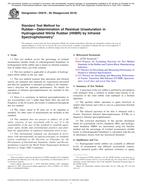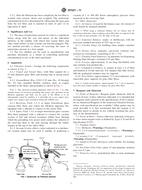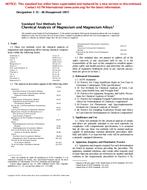1.1 This guide covers the identification of metals and alloys in computerized material property databases. It establishes essential and desirable data elements that serve to uniquely identify and describe a particular metal or alloy sample as well as properties that identify a given metal or alloy in general.
1.1.1 This guide does not necessarily provide sufficient data elements to describe weld metal, metal matrix composites, or joined metals.
1.1.2 The data element identified herein are not all germane to every metal or alloy group.
1.1.3 Different sets of data elements may also be applied within a given metal or alloy group depending on conditions or applications specific to that metal or alloy group. Further, within a particular metal or alloy group, different sets of data elements may be used to identify specific material conditions.
1.1.4 Table 1 on Recommended Data Elements and on values for specific data elements appear at the end of this guide.
1.2 Some of the data elements in this guide may be useful for other purposes. However, this guide does not attempt to document the essential and desirable data element for any purpose except for the identification of metals and alloys in computerized material property databases. Other purposes, such as material production, material procurement, and material processing, each may have different material data reporting requirements distinct from those covered in this guide. A specific example is the contractually required report for a material property testing series. Such a report may not contain all the data elements considered essential for a specific computerized database; conversely, this guide may not contain all the data elements considered essential for a contracted test report.
1.3 Results from material tests conducted as part of the procurement process are often used to determine adherence to a specification. While this guide includes a number of test result data elements, such data elements are included in this guide only for the purposes of material identification.
1.4 Reporting of contracted test results, such as certification test results, shall follow the requirements described in the material specification, or as agreed upon between the purchaser and the manufacturer.
1.5 This guide contains a limited number of data elements related to material test results. These data elements are for material identification purposes and are not intended to replace the more detailed sets of data elements listed in guides such as Guide E 1313 covering data recording formats for mechanical testing of metals. For material identification purposes, the data elements in this guide include typical, nominal, or summary properties normally derived from a population of individual specimen tests. If warranted by the scope of a particular database system, the system might provide links between the material identification data elements given in this guide, and the individual specimen test results recorded in accordance with other guides corresponding to particular test methods.
1.6 Material Classes – See ANSI/AWS A9.1-92 for arc welds, Guide E 1308 for polymers, Guide E 1309 for composite material, and Guide E 1471 for fibers, fillers, and core materials. ASTM Committee E49 is developing guides for other material classes.
Product Details
- Published:
- 09/10/2003
- Number of Pages:
- 12
- File Size:
- 1 file , 70 KB


